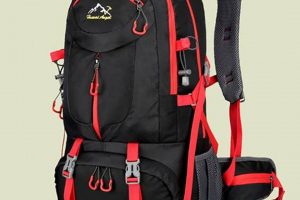The ideal pack for extended wilderness treks is a crucial piece of gear, facilitating the transport of necessary equipment and supplies over long distances. These specialized packs are designed to accommodate the substantial weight and volume required for multi-day expeditions, such as thru-hikes. As an example, such equipment might include a tent, sleeping bag, cooking system, food, water, and clothing appropriate for varied weather conditions.
The selection of a suitable pack contributes significantly to the overall success and enjoyment of a long-distance hike. A well-fitted and appropriately sized pack distributes weight efficiently, minimizing strain on the body and reducing the risk of injury. The evolution of these packs reflects advancements in materials, design, and ergonomic considerations, resulting in lighter, more durable, and more comfortable options for hikers.
The following sections will delve into key factors to consider when selecting a pack for long-distance hiking, encompassing aspects such as capacity, fit, weight, features, and materials. These considerations will aid in determining the most suitable pack for individual needs and planned expeditions.
Selection Guidance
Choosing the right pack for extended wilderness treks requires careful consideration of several factors. The following guidelines offer insights into optimizing this important decision.
Tip 1: Prioritize Fit: Proper torso length measurement is paramount. The pack’s frame should align with the spine, transferring weight effectively to the hips. Consult sizing charts and, ideally, undergo a professional fitting.
Tip 2: Optimize Capacity: Evaluate the anticipated duration and gear requirements of the planned hike. Packs typically range from 50 to 75 liters for extended trips. Avoid overpacking to minimize weight.
Tip 3: Scrutinize Weight: Each additional ounce contributes to fatigue over long distances. Lighter materials, such as Dyneema or lightweight nylon, can significantly reduce the overall pack weight.
Tip 4: Assess Suspension System: A robust suspension system, including padded shoulder straps and a supportive hip belt, is essential for distributing weight comfortably and preventing pressure points.
Tip 5: Evaluate Features: Consider desired features, such as external pockets for water bottles, trekking pole attachments, and rain covers. Balance feature set with weight considerations.
Tip 6: Consider Material Durability: The pack’s fabric should withstand abrasion and exposure to the elements. Reinforcements in high-wear areas, such as the bottom and sides, enhance longevity.
Tip 7: Examine Accessibility: A pack with multiple access pointstop, front, and sidecan greatly simplify gear retrieval, especially when the pack is fully loaded.
Careful adherence to these guidelines will enhance the likelihood of selecting a pack that performs reliably and comfortably throughout the duration of the trek.
The subsequent section will explore specific pack models that exemplify these characteristics and are well-suited for long-distance hiking endeavors.
1. Capacity
Capacity is a defining characteristic of a pack designed for extended wilderness treks. It dictates the volume of gear and supplies a hiker can carry, directly influencing the feasibility and safety of long-distance expeditions. Insufficient capacity necessitates compromising essential equipment, potentially leading to discomfort, hardship, or even dangerous situations in unpredictable environments. Conversely, excessive capacity encourages overpacking, contributing to unnecessary weight and increased physical strain.
Optimal capacity depends on several factors, including trip duration, environmental conditions, and individual hiking style. A longer trek inherently requires greater capacity to accommodate larger food reserves, fuel supplies, and additional clothing layers for varied weather. Ultralight hikers may opt for lower-capacity packs, relying on minimalist gear and meticulous packing techniques. However, those prioritizing comfort or requiring specialized equipment, such as photography gear, may necessitate larger packs. For example, a week-long hike in a temperate climate might require a 60-liter pack, while a multi-week excursion in mountainous terrain could necessitate a 70-75 liter capacity.
Understanding the relationship between pack capacity and trip requirements is essential for a successful and enjoyable long-distance hike. Careful consideration of these factors allows for the selection of a pack that balances the need for adequate gear storage with the imperative of minimizing weight and maximizing comfort. Choosing the right capacity allows a hiker to confidently face the challenges of extended wilderness travel.
2. Fit
The critical relationship between a pack and the wearer’s body is termed “fit.” The proper fit is paramount for comfort, efficiency, and injury prevention during extended wilderness treks. An ill-fitting pack can lead to discomfort, chafing, back pain, and ultimately, a compromised hiking experience. Pack fit impacts load distribution, stability, and overall biomechanics. Proper fit ensures efficient load transfer to the hips and legs, minimizing strain on the shoulders and back.
- Torso Length Measurement
Torso length, the vertical distance between the iliac crest and the C7 vertebra, is the primary determinant of pack size. Manufacturers typically offer packs in small, medium, and large sizes corresponding to specific torso length ranges. Accurate torso measurement is essential to selecting the correct size. A pack that is too long or too short will not distribute weight properly, leading to discomfort and potential injury. For example, a hiker with a 19-inch torso requires a medium-sized pack in most brands.
- Hip Belt Placement
The hip belt is responsible for bearing the majority of the pack’s weight, ideally around 70-80%. The top of the hip belt should sit comfortably on the iliac crest, allowing the skeletal structure to support the load rather than the soft tissues of the abdomen. An improperly positioned hip belt can lead to pressure points, chafing, and inefficient weight transfer. Many packs feature adjustable hip belts to accommodate varying hip circumferences and body shapes.
- Shoulder Strap Adjustment
Shoulder straps primarily stabilize the pack and prevent it from swaying, rather than bearing significant weight. The straps should contour comfortably over the shoulders without digging in or creating pressure points. Adjustable load lifter straps, which connect the shoulder straps to the pack frame, help pull the pack closer to the body, improving stability and weight distribution. Proper shoulder strap adjustment ensures a balanced and comfortable carry.
- Load Distribution and Stability
A well-fitted pack evenly distributes weight across the torso and hips, promoting stability and reducing the risk of imbalance. Internal frame packs, which feature rigid frames that transfer weight directly to the hip belt, generally offer superior load distribution compared to frameless or external frame packs. A pack with a low center of gravity and a snug fit provides enhanced stability on uneven terrain. Packing heavier items closer to the spine also improves balance.
Proper pack fit is not a one-size-fits-all proposition; it requires careful measurement, adjustment, and ultimately, trial and error. Consulting with experienced outfitters or retailers can provide valuable guidance in selecting a pack that fits properly and meets individual needs. Ignoring the importance of fit can lead to discomfort, injury, and a diminished experience when undertaking extended wilderness treks.
3. Weight
The attribute of weight is a primary consideration in the selection of packs intended for extended wilderness treks. Minimizing the load carried directly impacts endurance, agility, and the overall feasibility of long-duration expeditions. Pack weight encompasses both the empty weight of the pack itself and the cumulative weight of its contents.
- Base Weight Reduction
Base weight, defined as the weight of the pack and all gear excluding consumables like food and water, is a key metric for evaluating pack efficiency. Reducing base weight necessitates careful selection of lightweight materials and minimalist design. For example, switching from a traditional nylon pack to a Dyneema Composite Fabric (DCF) pack can shave several ounces. Further weight reduction can be achieved by opting for a frameless or minimalist frame design, provided it remains suitable for the anticipated load.
- Material Impact on Weight
The materials used in pack construction significantly influence overall weight. High-denier nylon fabrics, while durable, tend to be heavier than lighter alternatives like Robic nylon or DCF. Similarly, heavier buckles, zippers, and webbing contribute to increased weight. Manufacturers often employ strategic material selection, utilizing lighter fabrics in non-critical areas and heavier materials in high-stress zones to balance durability and weight.
- Suspension System Weight
The suspension system, including the frame, hip belt, and shoulder straps, plays a critical role in weight distribution and comfort but also adds to the overall pack weight. Lighter frames, often constructed from aluminum or carbon fiber, can reduce weight compared to heavier steel frames. Similarly, minimalist hip belts and shoulder straps, while potentially less supportive for heavier loads, offer significant weight savings. Trade-offs between comfort, load-carrying capacity, and weight must be carefully considered.
- Weight Distribution Strategies
While the pack’s empty weight is fixed, the distribution of weight within the pack affects perceived weight and balance. Packing heavier items closer to the spine and lower in the pack improves stability and reduces strain. Utilizing compression straps to consolidate the load and prevent shifting also enhances carrying efficiency. Strategic packing can effectively minimize the negative impact of a heavier load.
The pursuit of lightweight packs for long-distance hiking is a constant balancing act between durability, comfort, and load-carrying capacity. Understanding the various factors that contribute to pack weight allows for informed decision-making and ultimately enhances the enjoyment and success of extended wilderness adventures.
4. Durability
Durability is a fundamental attribute of any pack intended for extended wilderness treks. The harsh conditions encountered during these expeditions necessitate robust construction and resilience to abrasion, tearing, and prolonged exposure to the elements. A failure in pack integrity can compromise gear security, hinder mobility, and potentially endanger the hiker.
- Fabric Strength and Denier Rating
Fabric strength, often indicated by its denier rating, is a primary determinant of durability. Higher denier ratings signify thicker, more robust fabrics capable of withstanding greater stress and abrasion. For example, a pack constructed from 420D nylon will generally exhibit greater resistance to tearing than one made from 210D nylon. Reinforcements in high-wear areas, such as the bottom panel and side panels, further enhance overall pack durability. Real-world examples include packs used on rocky trails, where abrasion resistance is critical, or in dense forests, where packs may encounter snagging hazards.
- Seam Construction and Reinforcement
Seam construction significantly impacts the overall structural integrity of a pack. Reinforced seams, typically achieved through double or triple stitching, distribute stress more effectively and prevent seam failure under heavy loads. Bar-tack stitching at stress points, such as strap attachment points and zipper ends, further reinforces these critical areas. An example of this is seen in packs designed for carrying heavy loads, where reinforced seams are crucial for preventing the pack from falling apart at critical joints during long, arduous treks.
- Water Resistance and Weatherproofing
Prolonged exposure to moisture can degrade pack materials and compromise gear integrity. Water-resistant coatings, such as Durable Water Repellent (DWR) treatments, provide an initial barrier against light rain and snow. Waterproof fabrics, such as those utilizing waterproof membranes or coatings, offer greater protection in sustained wet conditions. However, even waterproof packs may require supplemental protection, such as rain covers or dry bags, to ensure complete gear protection during prolonged submersion or heavy downpours. For instance, a pack used in a rainforest environment would require a high degree of water resistance to prevent moisture damage to the contents, such as sleeping bags or electronic devices.
- Component Quality and Longevity
The quality of components, such as zippers, buckles, and webbing, directly influences pack durability. High-quality zippers, typically constructed from metal or durable plastic, resist breakage and ensure smooth operation. Robust buckles, made from durable plastics or metal alloys, withstand repeated use and prevent accidental release. High-strength webbing, used for straps and compression systems, resists stretching and abrasion. A real-world example would be a pack with cheap zippers that break easily, rendering compartments unusable, or buckles that snap under pressure, compromising the pack’s ability to securely carry gear.
The multifaceted nature of durability underscores its importance in the context of packs designed for extended wilderness treks. By prioritizing robust materials, reinforced construction, weather resistance, and component quality, manufacturers can produce packs capable of withstanding the rigors of long-distance hiking and ensuring the safety and comfort of the hiker. Choosing a pack with high durability ratings ensures long-term reliability and reduces the risk of equipment failure in remote and challenging environments.
5. Accessibility
Accessibility, in the context of packs designed for extended wilderness treks, refers to the ease with which contents can be retrieved or stored. This characteristic directly impacts efficiency, organization, and overall user experience during long-distance hiking. A pack lacking accessibility features necessitates time-consuming unpacking and repacking, potentially exposing gear to the elements and causing frustration. Thus, accessibility is a critical component in defining “best thru hiking backpacks.” The absence of accessible design can transform simple tasks into major inconveniences. For example, needing to unpack an entire pack to access a first-aid kit delays treatment of injuries and increases the risk of complications.
Various design elements contribute to pack accessibility. These include multiple access points, such as top-loading, front-panel loading, and side-access zippers. Separate compartments, internal dividers, and external pockets facilitate organized storage and quick retrieval of frequently used items. External attachment points allow for securing items like trekking poles or water bottles, further enhancing accessibility. A well-designed pack balances accessibility with other considerations like weight, durability, and capacity. For instance, a pack with numerous pockets may offer excellent accessibility but add unnecessary weight. Prioritizing essential accessibility features, such as a dedicated hydration sleeve and easily accessible side pockets for water bottles and snacks, optimizes efficiency on the trail. A practical application involves strategic packing, placing frequently used items in easily accessible locations and less frequently used items in deeper compartments.
In summary, accessibility is an indispensable aspect of “best thru hiking backpacks,” directly influencing user experience and efficiency on the trail. Designs incorporating multiple access points, organized compartments, and external attachment options enhance usability and convenience. While balancing accessibility with other design considerations is necessary, prioritizing essential accessibility features contributes significantly to the overall functionality and user-friendliness of packs used for extended wilderness treks. The understanding of accessibility within this context provides hikers with informed decision-making capabilities when selecting gear that suits their particular requirements, ultimately leading to a more efficient and enjoyable trekking experience.
6. Suspension
The suspension system is a critical determinant in the performance of packs designed for extended wilderness treks. This system facilitates load transfer, weight distribution, and overall carrying comfort. A well-engineered suspension mitigates strain, enhances stability, and contributes significantly to the feasibility of long-duration expeditions. Its design directly impacts the user experience and the efficiency of movement across varied terrains, thus representing a central element in the assessment of “best thru hiking backpacks”.
- Frame Design and Load Transfer
The frame, typically constructed from aluminum or composite materials, serves as the structural foundation of the suspension system. Its primary function is to transfer the pack’s weight from the shoulders to the hips. Internal frame designs, common in modern packs, offer superior load distribution compared to external frame systems. The frame’s geometry and rigidity influence its ability to efficiently transfer weight, minimizing pressure points and maximizing stability. For example, a frame with optimized curvature aligns with the spine, promoting natural posture and reducing back strain. Inadequate load transfer results in discomfort and fatigue, especially during prolonged use.
- Hip Belt Construction and Comfort
The hip belt bears the majority of the pack’s weight, ideally around 70-80%. Its construction directly impacts comfort and load-bearing capacity. Contoured padding, often incorporating multiple layers of foam with varying densities, conforms to the hips and minimizes pressure points. Adjustable hip belts allow for customization to individual body shapes and sizes. A well-fitted hip belt secures the pack to the lumbar region, preventing swaying and maintaining stability. An insufficiently padded or poorly fitted hip belt can cause chafing, discomfort, and inefficient weight transfer, ultimately compromising the hiking experience. For packs to be regarded as “best thru hiking backpacks,” hip belt design and functionality are indispensable features.
- Shoulder Strap Ergonomics and Adjustability
Shoulder straps stabilize the pack and distribute a smaller portion of the overall weight. Ergonomic designs, featuring contoured shapes and padded construction, enhance comfort and prevent chafing. Adjustable shoulder straps allow for fine-tuning the fit and accommodating varying torso lengths. Load lifter straps, connecting the shoulder straps to the upper portion of the pack, help pull the pack closer to the body, improving balance and weight distribution. Improperly adjusted or poorly designed shoulder straps can create pressure points and restrict movement, hindering hiking performance. Shoulder straps can be customized to be more comfortable while hiking.
- Ventilation and Breathability
Extended physical exertion generates heat and perspiration, leading to discomfort and potential skin irritation. Ventilation channels and breathable mesh panels incorporated into the suspension system promote airflow and reduce moisture buildup. These features enhance comfort, particularly in warm weather conditions. Suspended mesh back panels create a gap between the pack and the back, allowing for greater air circulation. Inadequate ventilation results in excessive sweating, discomfort, and potential skin problems, negatively impacting the overall hiking experience. Ventilation for a backpack is essential for being “best thru hiking backpacks”.
The suspension system, encompassing frame design, hip belt construction, shoulder strap ergonomics, and ventilation, plays a critical role in the functionality and comfort of packs designed for extended wilderness treks. Optimizing these elements enhances load transfer, reduces strain, and improves overall user experience. The integration of these attributes represents a defining characteristic of a superior, high-performance pack and contributes significantly to its classification as one of the “best thru hiking backpacks” available.
Frequently Asked Questions
This section addresses common inquiries regarding the selection and utilization of packs specifically designed for extended wilderness treks.
Question 1: What constitutes the appropriate capacity for a thru-hiking pack?
Pack capacity should align with trip duration and gear requirements. Capacities typically range from 50 to 75 liters for extended treks. Individual needs will dictate the optimal volume.
Question 2: How is a proper pack fit determined?
Torso length, measured from the iliac crest to the C7 vertebra, is the primary determinant of pack size. Consult sizing charts and seek professional fitting assistance.
Question 3: What materials are most suitable for thru-hiking pack construction?
Durable, lightweight materials such as Dyneema Composite Fabric (DCF) or high-denier nylon are commonly employed. Material selection balances weight, durability, and water resistance.
Question 4: What features are essential in a thru-hiking pack suspension system?
A robust frame, padded hip belt, and adjustable shoulder straps are essential. The suspension system facilitates efficient weight transfer and minimizes strain.
Question 5: How can pack weight be effectively minimized for thru-hiking?
Selecting lightweight materials, minimizing unnecessary features, and optimizing packing techniques contribute to weight reduction.
Question 6: What considerations are important regarding pack accessibility?
Multiple access points, organized compartments, and external attachment options enhance accessibility. Strategic packing further optimizes gear retrieval.
In summation, pack selection for extended wilderness treks requires careful evaluation of capacity, fit, materials, suspension, weight, and accessibility. These factors contribute significantly to overall comfort and performance.
The subsequent article section will provide specific recommendations of pack models well-suited for thru-hiking applications.
Conclusion
This discourse has examined the critical attributes of packs designed for extended wilderness treks, underscoring the significance of capacity, fit, weight, durability, accessibility, and suspension system efficacy. These elements collectively determine the suitability of equipment for long-duration expeditions. A comprehensive understanding of these factors is essential for informed decision-making.
The selection of a pack represents a pivotal investment in the success and safety of any thru-hiking endeavor. Therefore, rigorous evaluation and informed choice are paramount. The optimal pack will withstand the challenges of the trail, providing both comfort and functionality throughout the journey. Subsequent research and consideration of specific models are encouraged to facilitate the selection of the most appropriate equipment for individual needs and planned expeditions.



![Best Target Hiking Backpack [Deals] & Reviews Ultimate Backpack Traveler Guide: Tips, Destinations & Budget Hacks Best Target Hiking Backpack [Deals] & Reviews | Ultimate Backpack Traveler Guide: Tips, Destinations & Budget Hacks](https://backpack-traveler.com/wp-content/uploads/2025/10/th-619-300x200.jpg)



